What is “the environment”, and how do individual and group perspectives shape the way that people or groups behave towards it?
The “Draw an Environment” (DAE) test aims to analyze preconceived notions on individual and group perspectives of “the environment”. In the test, participants are told to draw “the environment”, and their depictions are analyzed by the researchers.
In my version of the “Draw an Environment” test, I surveyed fifteen members of the University of Nebraska-Lincoln’s Climbing Club. This student organization meets once a week on Sundays to climb in the Outdoor Adventures Center on campus, and occasionally some members will go to climbing competitions in Nebraska and around the Midwest.
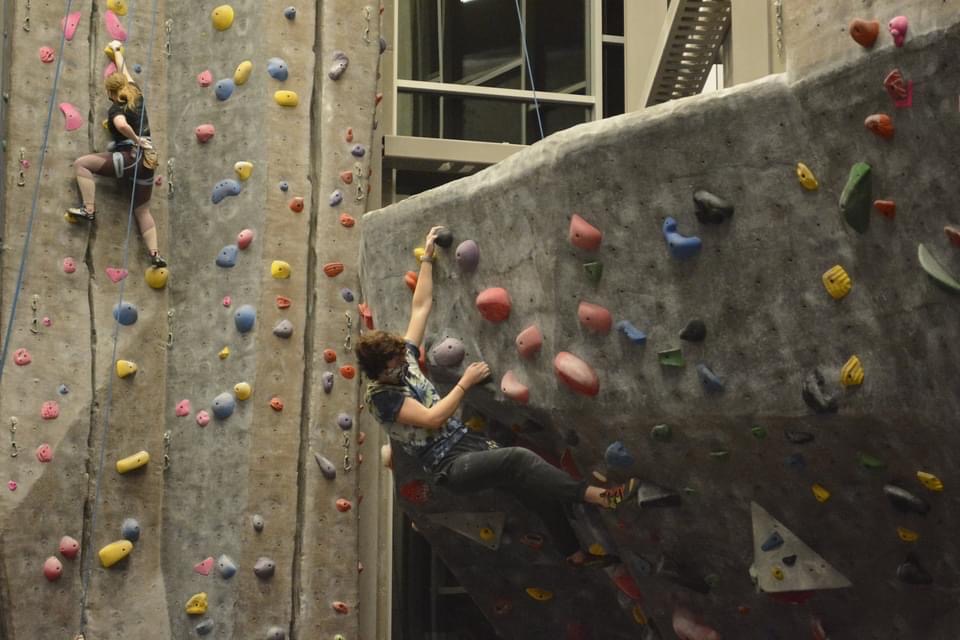
I chose to survey the UNL Climbing Club members due to my access to them as a fellow group member, and I was curious to uncover their relationship to “the environment” as physically-inclined people.
After our Sunday meeting, I administered lined pieces of paper to those who wanted to participate. I told the participants to draw the environment, to label anything they thought needed a description, and to write their age somewhere on the page.
The following images are the fifteen drawings that I received from the Climbing Club members. They have been randomized, anonymized, and numbered.
Click on an image to enlarge it and view a description
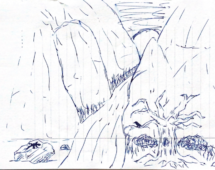
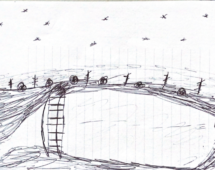
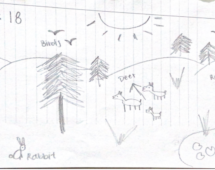
![Two deer standing among grass, trees, and a river or walkway. "[T]rash :(" is laying to the right of a tree.](https://trinityothompson.com/wp-content/uploads/cache/2022/02/5-e1644713588502/226812932.png)
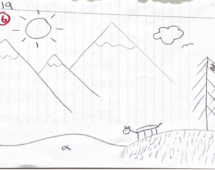
![A tree has a bird perched on a branch. To the left of the tree is a "fire man" that is "call[ing] upon nature". Unclear what that means.](https://trinityothompson.com/wp-content/uploads/cache/2022/02/7/2717552042.png)
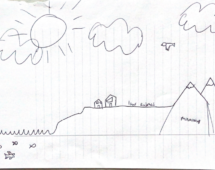
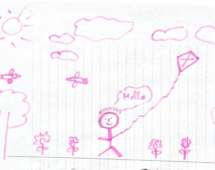
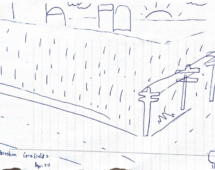
![A "park-ish setting" with a tree, grass, flowers, and two people playing frisbee. Participate "[t]ried to draw animals but gave up".](https://trinityothompson.com/wp-content/uploads/cache/2022/02/11-e1644712484269/4096993761.png)
Analysis
To analyze the drawings, I created an Excel sheet and tallied up the natural and human-involved elements of each picture. I then converted them into percents, converted the percents into graphs, and compared pictures that shared similar elements.
For those that are familiar with this experiment, you may be shocked at the percentage of these drawings that are completely or mostly void of human influence or interaction.
100%
of all drawings included elements of the natural* environment
47%
of all drawings included or eluded to human interaction or involvement in natural elements
*Although there are few areas on earth that are untouched or uninfluenced by humans, for the purposes of this experiment, “natural” is defined as elements of the earth that are not directly or obviously impacted or connected to humans.
A few drawings were of specific places (from left to right, The Galápagos Islands; Nebraska cornfields; and La Crosse, Wisconsin):
These specific locations demonstrate a piece of each participants’ environmental identity. To them, these environments are crucial to their relationships with the earth, so crucial, in fact, that these are the locations that come to their minds when they think of “the environment”.
Unlike other DAE tests, not one of the participants drew human-centric environments such as a city or the classroom in which we sat. This could have to do with the demographic of the participants in this study; people who climb likely have more connections to outdoor environments than a general city population.
Natural Elements
As far as the included natural elements from each drawing, below is a graphical breakdown of the percentage of all fifteen of the drawings that included the following natural features:
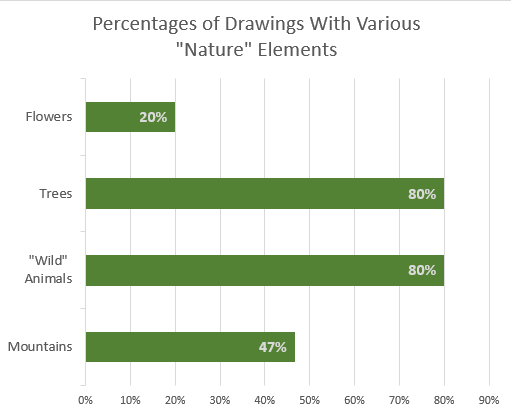
Trees and “wild” animals (used in quotes to acknowledge that most “wild” animals are not truly wild and have endured some human impact) prevailed among the participants’ concepts of the environment. Most drawings included coniferous or deciduous trees:
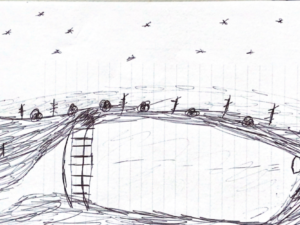
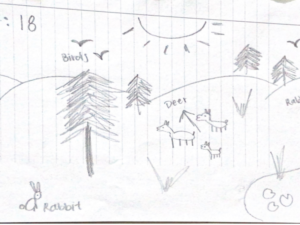
However, a couple of drawings included unique trees or tree perspectives, such as the palm tree on the left and the tree on the right where the viewer seems to be in the tree or very close to it.
The wild animals ranged from owls to fish to rabbits to deer:
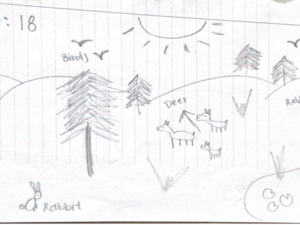
![Two deer standing among grass, trees, and a river or walkway. "[T]rash :(" is laying to the right of a tree.](https://trinityothompson.com/wp-content/uploads/cache/2022/02/5-e1644713588502/4041008414.png)
Although flowers don’t play a massive role in most big-picture environmental scenes, they seemed to be added in an aesthetic way among participants that drew park-like representations:
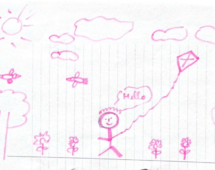
And, of course, almost half of the drawings included mountains. I did expect more participants to draw mountains due to the fact that they are all in a climbing club that teaches skills applicable to climbing mountains.
Human Elements
For this study, human elements refer to aspects of the environment that have been altered or impacted by humans on a more direct level. A breakdown of human elements that were found in the drawings are displayed below:
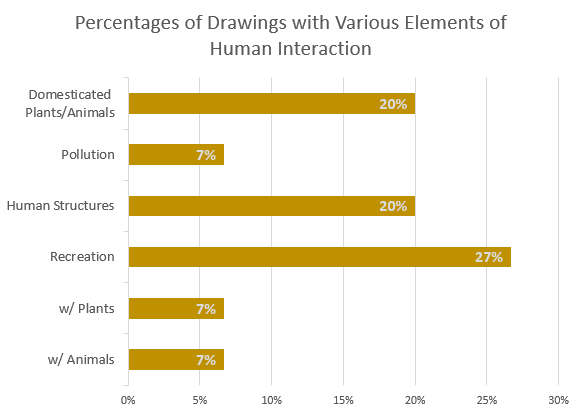
Again, keep in mind that only 47% of all of the drawings included human involvement at all, and this graph represents the fraction of these elements that were present in all fifteen of the drawings, not just those that included humans.
Only one drawing depicted direct human pollution (littering is labeled as “trash” on the right side of the image):
The lack of human pollution in the drawings could be due to the nature-centric view that people who participate in outdoor recreation (like climbing) typically share. On one side, they appreciate the natural world, but on the other, they are disregarding the human impact on natural environmental elements.
A few depictions, shown below, did include structures built by humans, but the effects of these constructions (such as pollution or animal/plant displacement) on the surrounding environment are absent.
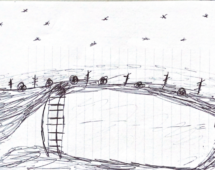
Although the implications of domesticated animals and crops might have been lost on the participants that included them, they represent the massive power dynamic of control between humans and the natural world:
Finally, I was surprised by the representation of human recreation in the environment as shown in the following illustrations:
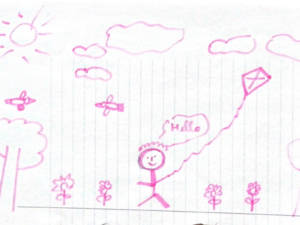
![A "park-ish setting" with a tree, grass, flowers, and two people playing frisbee. Participate "[t]ried to draw animals but gave up".](https://trinityothompson.com/wp-content/uploads/cache/2022/02/11-e1644712484269/2415629875.png)
I really appreciated these drawings! They depict harmony and balance between people interacting peacefully (the fishing, however, is probably not peaceful for the fish) with the natural elements of the environment.
Research Questions
What mental models do X have about the environment?
Overall, members of the UNL Climbing Club exhibited positive and serene mental models around the environment. Many of the depictions show either no direct human involvement with the environment or minimally invasive human interaction. They largely value wildlife, trees, and the solitude of being out in open, natural spaces that are “untouched by humanity”.
What are the implications of these mental models for
how the environment is perceived?
As previously mentioned, the lack of acknowledgment about negative humanitarian impacts on the environment could demonstrate ignorance or simply a purposeful admission due to the harsh truth of human impact on the earth. However, the regard for the natural world, as opposed to the built world, demonstrates awareness and appreciation for the earth, so we could assume that this group of individuals is more prone to make environmentally conscious choices in their day-to-day lives.
Takeaways
This research preaches the value of environmental education and engagement in the effort to create environmental identity and promote sustainable practices. The UNL Climbing Club represents a group that has attachments to nature through the hobby of climbing, as demonstrated in their environment drawings. As such, they have environmental identities that are developed through nature, and due to this limb of their identity, they are more likely to practice sustainability in their lives.
If more people had environmental identities that were as nature-centered as the UNL Climbing Club, it might be more efficient to teach about ways that people can help the environment because they will have a reason to care. People aren’t motivated if they don’t care. As such, resources like the UNL Outdoor Adventures Center provide an invaluable service to the fight for a cleaner, more sustainable earth through environmental education.
!["This is a beautify sandy beach found in the [Galapagos] Islands".](https://trinityothompson.com/wp-content/uploads/cache/2022/02/3-e1644713802226/931096707.png)




!["This is a beautify sandy beach found in the [Galapagos] Islands".](https://trinityothompson.com/wp-content/uploads/cache/2022/02/3-e1644713802226/2010558476.png)


![A "park-ish setting" with a tree, grass, flowers, and two people playing frisbee. Participate "[t]ried to draw animals but gave up".](https://trinityothompson.com/wp-content/uploads/cache/2022/02/11-e1644712484269/2597795167.png)

!["This is a beautify sandy beach found in the [Galapagos] Islands".](https://trinityothompson.com/wp-content/uploads/cache/2022/02/3-e1644713802226/4211010037.png)
![A tree has a bird perched on a branch. To the left of the tree is a "fire man" that is "call[ing] upon nature". Unclear what that means.](https://trinityothompson.com/wp-content/uploads/cache/2022/02/7/2500961129.png)


![A "park-ish setting" with a tree, grass, flowers, and two people playing frisbee. Participate "[t]ried to draw animals but gave up".](https://trinityothompson.com/wp-content/uploads/cache/2022/02/11-e1644712484269/1054537827.png)

![Two deer standing among grass, trees, and a river or walkway. "[T]rash :(" is laying to the right of a tree.](https://trinityothompson.com/wp-content/uploads/cache/2022/02/5-e1644713588502/1881292854.png)






